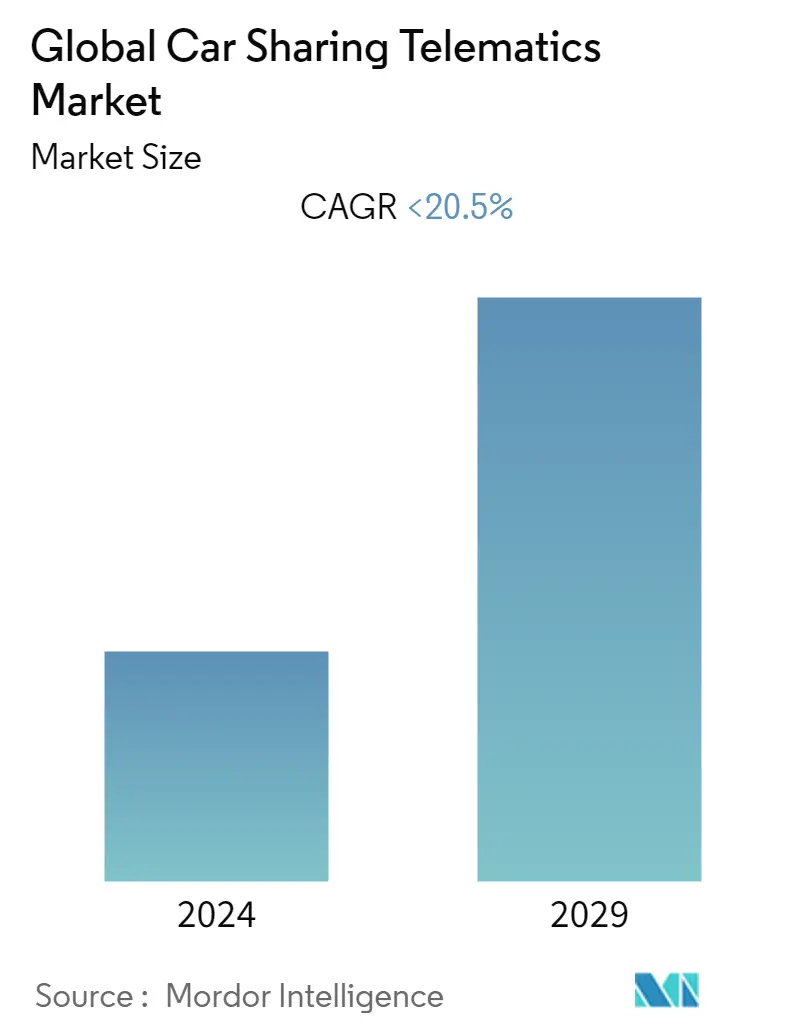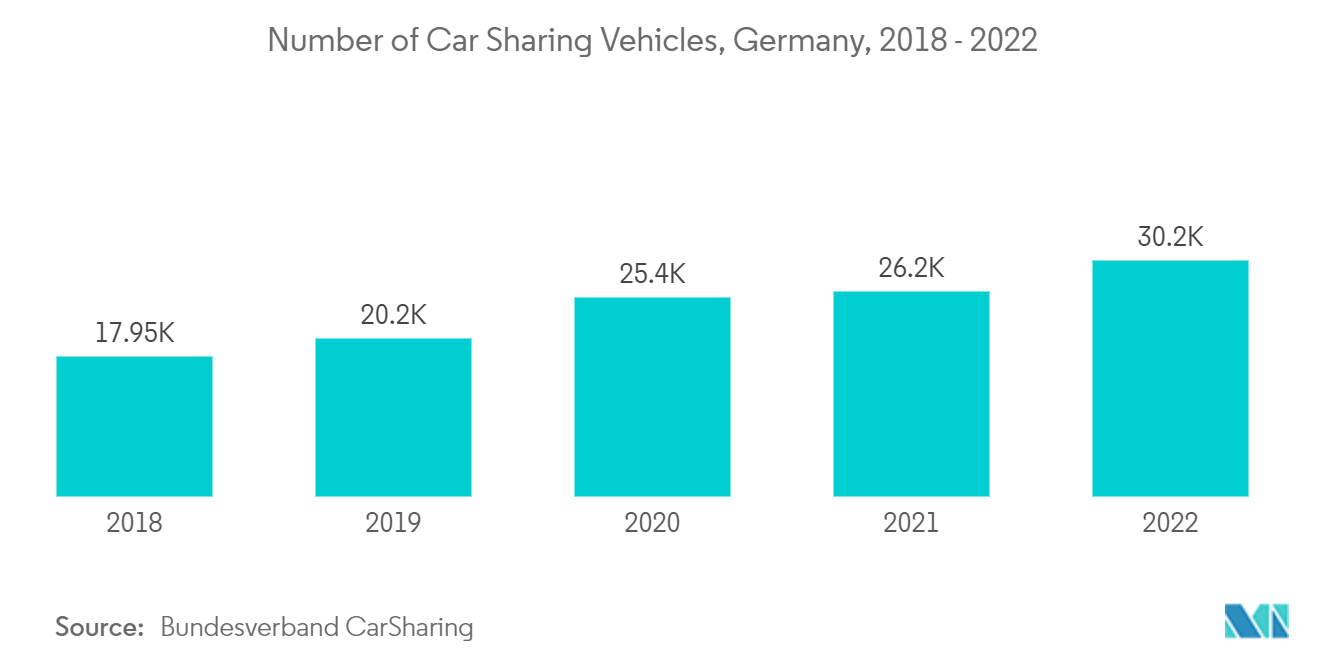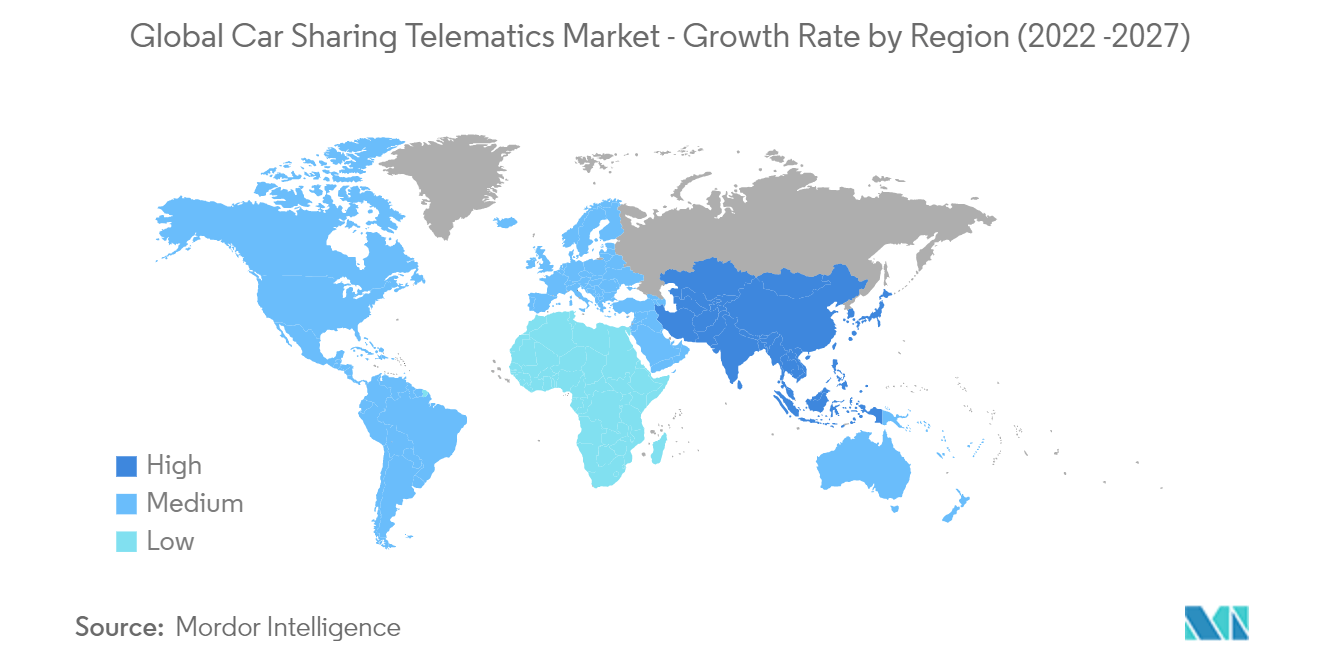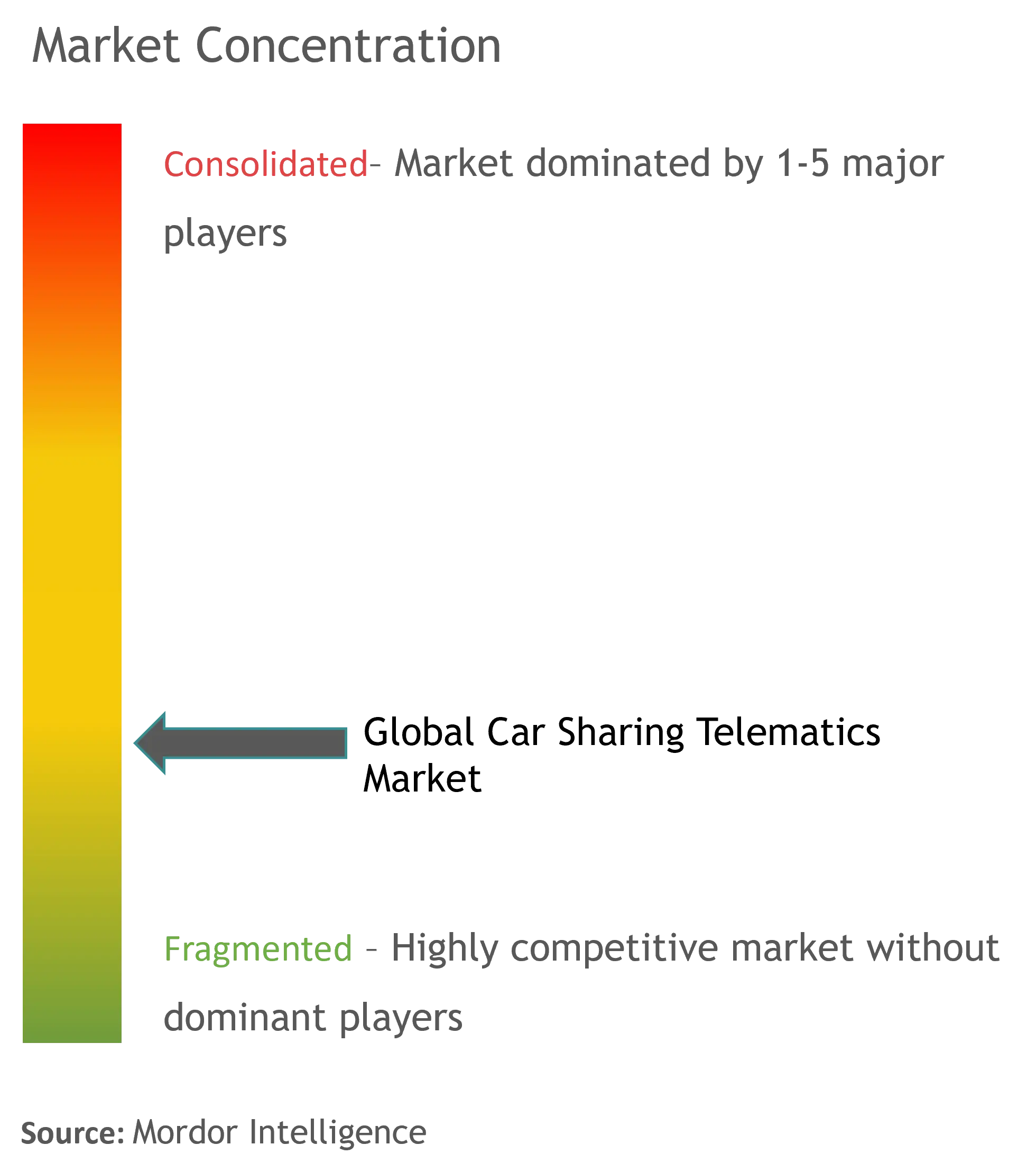Car Sharing Telematics Market Size

| Study Period | 2019 - 2029 |
| Base Year For Estimation | 2023 |
| CAGR | < 20.50 % |
| Fastest Growing Market | Asia-Pacific |
| Largest Market | Europe |
| Market Concentration | Low |
Major Players
*Disclaimer: Major Players sorted in no particular order |
Car Sharing Telematics Market Analysis
The Global Car Sharing Telematics Market is expected to register a CAGR of 20.5% over the forecast period from 2022 to 2027. The global automotive industry is disrupted by rapid demand for autonomous, connected, electric, and shared driving in the current market, causing unprecedented technology and business transformation. Moreover, amid the COVID crisis, it is causing additional stress on the industry due to disruptions in supply and manufacturing, followed by a demand surge with uncertainty concerning the recovery timeline, which will impact the market growth.
Car sharing is one of the services given and managed in a station-based mode, primarily used for corporate solutions. It allows employees to arrange business trips by renting a vehicle in advance and for the required length, driving the market growth. Alternatively, local governments or multi-utilities that operate the public mobility service and seek to meet the varied requirements of customers, such as the ability to use the vehicle when needed, can provide a free-floating mode in addition to the former.
Fuel is usually included in the price of car-sharing, meaning a user does not have to pay for it. As a result, the issue of reducing gasoline expenses for car-sharing business owners is particularly significant, and telematics allows to monitor several factors that affect fuel consumption, including Idling, driving behavior (aggressive driving increases fuel consumption), weather (low temperatures promote higher fuel consumption), and use of accessories (air conditioning, etc.). Such factors will drive market growth.
Furthermore, organizations can use video telematics to create a platform to make decisions based on data, give predictive analytics, and help enterprises solve large-scale challenges. Furthermore, with telematics, businesses will have the widespread capability in fleet vehicles, which will help fleets eliminate logistical hassles. As a result of the use of fleet telematics, the market opportunities are projected to grow.
The high installation cost is a significant obstacle for the car-sharing telematics sector. Because the initial configuration of telematics systems, as well as its ongoing maintenance, can be costly. Furthermore, the cost of fuel may further strain the organization. As a result, the high cost of car-sharing telematics may limit the market's growth.
Car Sharing Telematics Market Trends
This section covers the major market trends shaping the Car Sharing Telematics Market according to our research experts:
AI, IoT and Cloud Car Sharing Telematics Solutions Expected to Drive the Market Share
To keep drivers and passengers safe, video telematics solutions in the market are combining machine vision and artificial intelligence. Unlike traditional telematics solutions, which only capture the time and location of an incident and possibly some of the mechanical reasons for the incident, such as hard braking or swerving, video telematics solutions capture the entire picture inside and outside the car to truly demonstrate why an incident occurred.
One of the cores enabling technology responsible for the deployment of TCU is 5G. The technology's low latency, massive density, super-fast download speeds, and device awareness, among others, draw new capabilities and experiences critical for car-sharing driving systems. Additionally, the market seeks to leverage opportunities in line with smartphone features that enable an era of mobility-as-a-service.
Telematics has proven to be an essential component of vehicle industries. It has increased the capabilities of standard onboard vehicle navigation and guidance systems and made it possible for vehicle and fleet owners to communicate more effectively within and amongst the vehicles. A cloud-based vehicle management system also opens up many new options and driving opportunities for car-sharing vendors.
Overall, Car-sharing companies aim to optimize their operations and better their systems for tracking and monitoring vehicles, controlling routes and diagnosing possible issues using IoT, AI, and cloud-based solutions.

Europe Expected to Witness Significant Market Share
The newer mobility services and business models have been changing urban transport, primarily affecting the supply and demand sides of the market. Internet penetration and high public transportation prices have also changed the transportation sector, and app-based mobility services, such as car-sharing via mobile applications, have offered new possibilities to expand and complement the existing services that could balance public and private transport in the region.
Mobility providers in the region aim to improve users' travel experiences by delivering an intuitive and fast user interface. This factor reduces the number of vehicles on the road and makes the transition to electric vehicles easier, resulting in lower CO2 emissions and environmental impact.
For instance, in November 2021, Targa Telematics, a technology firm specializing in the creation of digital solutions in the telematics, smart mobility, and mobility IoT platform fields, introduced Targa Smart Mobility, a solution that unifies all types of shared mobility on a single platform and the solution allows lower CO2 emissions and lower environmental impact. Targa Smart Mobility also incorporates the carpooling service, which is gaining traction in the market and allows numerous users, primarily corporate clients, to share a single ride.
Moreover, in January 2022, Continental, a technologies and services company for sustainable and connected mobility, expanded its partnership with SHARE NOW Denmark. The decision came after the two firms successfully worked on a tread-depth monitoring pilot project for the car-sharing service's fleet. The partnership will keep SHARE NOW Denmark's car-sharing fleet with intelligent tire management
Hence, various car-sharing telematics providers in the region view innovation and investments through new product launches, partnerships, and product improvisation as a lucrative path toward gaining agility, enhanced security, improved performance, increased efficiency, and maximizing market share.

Car Sharing Telematics Industry Overview
The Global Car Sharing Telematics Market is highly competitive, with many regional and global players. Innovation drives the market in the product offerings, and each vendor invests in innovation. Key players include INVERS GmbH, Convadis AG, MoC Sharing, Ridecell Inc., and Vulog
March 2022 - Invers, the automated vehicle sharing firm, partnered with Ubeeqo, one of Europcar Mobility Group's vehicle sharing brands, and is expanding the partnership by fitting additional vehicles in Ubeeqo's fleet with CloudBoxx, the company specialized sharing telematics unit.
February 2022 - OCTO Telematics and Ford Motor Company announced a new agreement to expand data streaming across Europe. OCTO will enhance its market-telematics services in insurance and analytical services in the UK, Italy, Germany, France, and Spain by leveraging Ford's linked car data.
Car Sharing Telematics Market Leaders
-
INVERS GmbH
-
Convadis AG
-
MoC Sharing
-
Ridecell, Inc
-
Vulog
*Disclaimer: Major Players sorted in no particular order

Car Sharing Telematics Market News
November 2021 - Wuddi and Ridecell Inc., one of the premier platforms for digital transformation and automation for fleet-based enterprises, announced a partnership to extend carsharing operations. Wuddi will employ the Ridecell Fleet IoT Automation Platform.
January 2021 - Vulog, a mobility technology provider, raised USD 31 million from the European Investment Bank (EIB) and its current investors. The investment is aimed at reducing carbon emissions, such as the provision of cleaner transportation options, among other things.
Car Sharing Telematics Market Report - Table of Contents
1. INTRODUCTION
1.1 Study Assumption and Market Definition
1.2 Scope of the Study
2. RESEARCH METHODOLOGY
3. EXECUTIVE SUMMARY
4. MARKET INSIGHTS
4.1 Market Overview
4.2 Porter's Five Forces Analysis
4.2.1 Bargaining Power Of Suppliers
4.2.2 Bargaining Power of Buyers
4.2.3 Threat Of New Entrants
4.2.4 Threat Of Substitutes
4.2.5 Intensity of Competitive Rivalry
4.3 Assessment of COVID-19 Impact on the Car Sharing Telematics Market
5. MARKET DYNAMICS
5.1 Market Drivers
5.1.1 Increasing IoT, AI, and Machine Learning based solutions for Carsharing Telematics
5.1.2 Increasing Autonomous vehicles are Anticipated to Transform the Carsharing Telematics Landscape
5.2 Market Challenges
5.2.1 High Installation Cost
6. MARKET SEGMENTATION
6.1 By Channel
6.1.1 Orginal Equipment Manufacturers (OEM)
6.1.2 Aftermarket
6.2 By Form
6.2.1 Embedded
6.2.2 Tethered
6.2.3 Integrated
6.3 By Geography
6.3.1 North America
6.3.2 Europe
6.3.3 Asia-Pacific
6.3.4 Latin America
6.3.5 Middle-East and Africa
7. COMPETITIVE LANDSCAPE
7.1 Company Profiles
7.1.1 INVERS GmbH
7.1.2 Convadis AG
7.1.3 Continental Aftermarket & Services
7.1.4 Octo Group S.p.A
7.1.5 Vulog
7.1.6 Ridecell, Inc
7.1.7 Mobility Tech Green
7.1.8 Targa Telematic
7.1.9 OpenFleet
7.1.10 WeGo B.V.
7.1.11 Fleetster
7.1.12 MoC Sharing
- *List Not Exhaustive
8. INVESTMENT ANALYSIS
9. FUTURE OF THE MARKET
Car Sharing Telematics Industry Segmentation
Carsharing Telematics enables the automatic collection of data by understanding the current condition of every car in the fleet. The data assists car-sharing companies in making informed financial decisions.
The study covers original equipment manufacturers (OEM) and aftermarket channel types and tracks the usage of car-sharing telematics across embedded, tethered, and integrated forms. The study also covers demand across various regions and considers the impact of COVID-19 on the car-sharing telematics market.
| By Channel | |
| Orginal Equipment Manufacturers (OEM) | |
| Aftermarket |
| By Form | |
| Embedded | |
| Tethered | |
| Integrated |
| By Geography | |
| North America | |
| Europe | |
| Asia-Pacific | |
| Latin America | |
| Middle-East and Africa |
Car Sharing Telematics Market Research FAQs
What is the current Global Car Sharing Telematics Market size?
The Global Car Sharing Telematics Market is projected to register a CAGR of less than 20.5% during the forecast period (2024-2029)
Who are the key players in Global Car Sharing Telematics Market?
INVERS GmbH, Convadis AG , MoC Sharing, Ridecell, Inc and Vulog are the major companies operating in the Global Car Sharing Telematics Market.
Which is the fastest growing region in Global Car Sharing Telematics Market?
Asia-Pacific is estimated to grow at the highest CAGR over the forecast period (2024-2029).
Which region has the biggest share in Global Car Sharing Telematics Market?
In 2024, the Europe accounts for the largest market share in Global Car Sharing Telematics Market.
What years does this Global Car Sharing Telematics Market cover?
The report covers the Global Car Sharing Telematics Market historical market size for years: 2019, 2020, 2021, 2022 and 2023. The report also forecasts the Global Car Sharing Telematics Market size for years: 2024, 2025, 2026, 2027, 2028 and 2029.
Global Car Sharing Telematics Industry Report
Statistics for the 2024 Global Car Sharing Telematics market share, size and revenue growth rate, created by Mordor Intelligence™ Industry Reports. Global Car Sharing Telematics analysis includes a market forecast outlook to 2029 and historical overview. Get a sample of this industry analysis as a free report PDF download.



